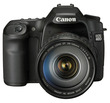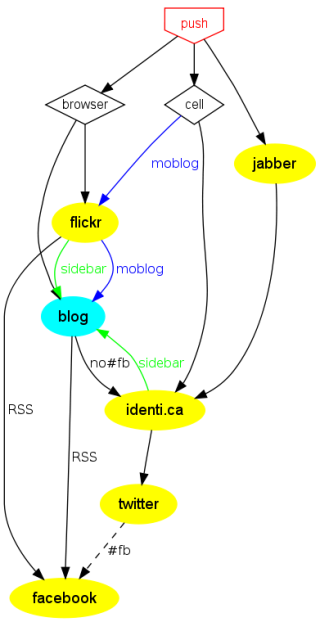Wednesday, October 14. 2009
Or what?

Tuesday, October 13. 2009
How to download videos from YouTube

Although there are some tools available that allow you to grab videos from YouTube to your local storage, I rely on this plain method (rarely, though):
- Load the video’s YouTube URL like http://www.youtube.com/watch?v=VIDEOID in your web browser.
- Look at the HTML source code and search for the string “video_id”. The video ID in the URL matches the string that follows.
- Scroll a bit to the right to the string “t” and copy the lengthy string that follows.
- Compose the download URL: http://youtube.com/get_video.php?video_id=VIDEOID&t=TSTRING
- Put this URL into your download manager. If using wget, put the URL into quotes; you might want to add -O nicefilename.flv.
Monday, September 21. 2009
Social web cascade

I guess mine is mostly harmless. (The “push” stands for first-time publications.)
(Just fooling around with GraphViz.)
Friday, September 18. 2009
Linux autorun FAIL

Monday, September 14. 2009
Conrad Paukner

14.09.2009, 10:46 Uhr, 48 cm, 3120 g.
Er war schon in der Babygalerie, da wussten noch nichtmal alle von seiner Ankunft. ![]() Ja ja, so ist das in den Zeiten des Internet: Man war schon online, bevor man grün in die Windel...
Ja ja, so ist das in den Zeiten des Internet: Man war schon online, bevor man grün in die Windel...
Alle sind wohlauf, und wir starten mit Freude das größte Projekt schlechthin.
Update: Aktuelle Fotos gibt’s laufend sowohl in der Babygalerie als auch in meinem Webalbum.
Friday, September 4. 2009
Light gain with fast lenses

I was interested what difference there is between the Canon EF 50mm f/1.2, f/1.4 and the f/1.8 model regarding the light gain compared to an f/2.8 lens. The amount of light that travels through an optical system is usually given by f-numbers, the relation between focal length and aperture diameter. Doubling or halving the diameter of the aperture results in quadrupling/quartering the aperture area and thus the amount of light that can fall through:
Practically it is of interest what f-numbers result in doubling/halving the amount of light,
,
what is thus given by an aperture diameter change factor of √2 ≈ 1.41. Continuously doubling/halving the light amount results in the diameter changing with the factors (√2)k, yielding the classical sequence
1.4 → 2.0 → 2.8 → 4.0 → 5.6 → 8.0 → ...
The switch from a lens with maximum f/2.8 to one with f/1.4 thus yields 4× as much light, allowing ¼ of the original exposure time. Between f/2.8 and f/2.0 there’s a factor of 2. So, switching f/2.8 to f/1.8 must gain light with a factor between 2 and 4. What’s the exact amount? It’s
So it’s even less than 2.5, while with an f/1.4 lens it’s a factor of 4! Thus, there’s quite a difference in the light amount between those two lenses. And what about the step from f/2.8 to f/1.2? The gain factor is calculated similarly: 5.44. The step from f/1.4 to f/1.2 only yields 1.36× more light.
Green thumb FAIL

Tuesday, September 1. 2009
A peek on current DSLR tech

The longer I own my DSLR, the less important it becomes, and the more important it is to focus on the pictures rather than the gear. However, Canon’s annual DSLR presentation was due, and so I had a peek on their new release: The EOS 7D, placed between the prosumer x0D-line (10D and up) and the professional 5D. What’s technically interesting me are
- 8 fps continuous shooting with a burst of 126 JPEGs or 15 RAWs
- 19-point AF with new modes
- Viewfinder with 1.0× magnification, 100% coverage and LCD overlay
- iFCL metering system that respects color
- HD-movie mode
- Dual 14-bit DIGIC 4 processing
It’s probably targeted against (the successor of) Nikon’s D300 that’s placed between their D90 and D700. While the D90 could be compared to the Canon 50D and the D700 to the Canon 5D, Canon lacked something in between so far.
The current hype to include a movie mode into DSLRs isn’t quite comprehensible to me. Maybe time will show whether video photography will become a style of its own. It appears to me that video capability and operability are rather limited, although the ability to choose between lenses is a big advantage. I’ll rather go for a dedicated camcorder nonetheless.
Regarding the pictures: While it’s still okay for me to be involved in casual techie debates (e.g. about astro photography), they become less interesting when it’s just about cameras. Only the output matters, so I don’t feel an urge to follow current developments in that detail. Unfortunately, I didn’t find the time to go out shooting as much as I had wished, due to priority reasons. However, my next main genre will apparently be child photography in great profusion. ![]()
While I’m at it, I was struggling a lot what tele lens I’d finally buy, thinking of getting things closer “out there”. Although Canon’s EF 100-400mm f/4.5-5.6 [review] has a disputed design and is more than 10 years old, Sigma’s recently introduced 120-400mm and 150-500mm lenses can’t outperform it. So it’ll probably join my gear in a few months. I also had tested Zeiss’ ZE Planar T* 50mm f/1.4, but I’m not sure whether I’d use such a lens often. Maybe Canon’s cheap EF 50mm f/1.8 II might be an option.
About
Calendar
| Mon | Tue | Wed | Thu | Fri | Sat | Sun |
|---|---|---|---|---|---|---|
| ← Back | December '25 | Forward → | ||||
| 1 | 2 | 3 | 4 | 5 | 6 | 7 |
| 8 | 9 | 10 | 11 | 12 | 13 | 14 |
| 15 | 16 | 17 | 18 | 19 | 20 | 21 |
| 22 | 23 | 24 | 25 | 26 | 27 | 28 |
| 29 | 30 | 31 | ||||



